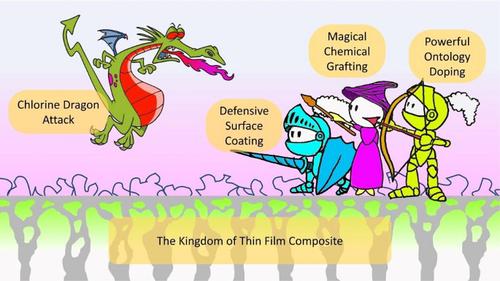Frontiers of Chemical Science and Engineering ( IF 4.5 ) Pub Date : 2021-11-23 , DOI: 10.1007/s11705-021-2109-z Pei Sean Goh 1 , Kar Chun Wong 1 , Tuck Whye Wong 1 , Ahmad Fauzi Ismail 1

|
Polyamide thin film composite membranes have dominated current reverse osmosis market on account of their excellent separation performances compared to the integrally skinned counterparts. Despite their very promising separation performance, chlorine-induced degradation resulted from the susceptibility of polyamide toward chlorine attack has been regarded as the Achilles’s heel of polyamide thin film composite. The free chlorine species present during chlorine treatment can impair membrane performance through chlorination and depolymerization of the polyamide selective layer. From material point of view, a chemically stable membrane is crucial for the sustainable application of membrane separation process as it warrants a longer membrane lifespan and reduces the cost involved in membrane replacement. Various strategies, particularly those involved membrane material optimization and surface modifications, have been established to address this issue. This review discusses membrane degradation by free chlorine attack and its correlation with the surface chemistry of polyamide. The advancement in the development of chlorine resistant polyamide thin film composite membranes is reviewed based on the state-of-the-art surface modifications and tailoring approaches which include the in situ and post-fabrication membrane modifications using a broad range of functional materials. The challenges and future directions in this field are also highlighted.
中文翻译:

聚酰胺薄膜复合反渗透膜的表面定制耐氯材料和策略
聚酰胺薄膜复合膜由于与整体蒙皮的对应物相比具有出色的分离性能,因此在当前的反渗透市场上占据主导地位。尽管它们具有非常有前途的分离性能,但由于聚酰胺对氯侵蚀的敏感性而导致的氯诱导降解被认为是聚酰胺薄膜复合材料的致命弱点。氯处理过程中存在的游离氯物质会通过聚酰胺选择性层的氯化和解聚而损害膜性能。从材料的角度来看,化学稳定的膜对于膜分离过程的可持续应用至关重要,因为它保证了更长的膜寿命并降低了更换膜的成本。各种策略,尤其是那些涉及膜材料优化和表面改性的技术,已经建立来解决这个问题。本综述讨论了游离氯侵蚀造成的膜降解及其与聚酰胺表面化学的相关性。基于最先进的表面改性和定制方法,回顾了耐氯聚酰胺薄膜复合膜的发展进展,包括使用广泛的功能材料进行原位和制造后膜改性。还强调了该领域的挑战和未来方向。



























 京公网安备 11010802027423号
京公网安备 11010802027423号